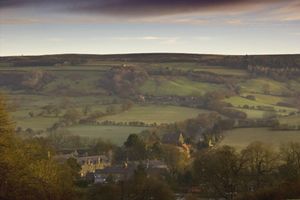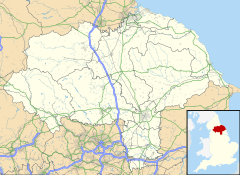Rosedale Abbey facts for kids
Quick facts for kids Rosedale Abbey |
|
|---|---|
 Rosedale Abbey |
|
| OS grid reference | SE726955 |
| • London | 200 mi (320 km) S |
| Unitary authority |
|
| Ceremonial county | |
| Region | |
| Country | England |
| Sovereign state | United Kingdom |
| Post town | PICKERING |
| Postcode district | YO18 |
| Dialling code | 01751 |
| Police | North Yorkshire |
| Fire | North Yorkshire |
| Ambulance | Yorkshire |
| EU Parliament | Yorkshire and the Humber |
| UK Parliament |
|
Rosedale Abbey is a small village in North Yorkshire, England. It's located about 8 miles (13 km) north-west of Pickering. The village is nestled within Rosedale, which is a beautiful part of the North York Moors National Park.
History of Rosedale Abbey
The Old Priory
A long time ago, around 1158, a priory was built here. It was a special home for nuns of the Cistercian order. Nuns are women who dedicate their lives to religious service. Rosedale was one of 24 nunneries in Yorkshire back then.
The nuns at Rosedale Priory were known for being the first people to farm sheep in the area. This was a common practice for Cistercian communities. They wanted to live simply and away from busy towns.
- The priory was founded around 1158.
- It was home to Cistercian nuns.
- They were pioneers in sheep farming in the region.
- The priory closed in 1536. This happened because of Henry VIII's dissolution of the monasteries, when many religious buildings were shut down.
Today, not much is left of the original priory building. You can still see a stair turret, a sundial, and one stone pillar. The local church, called St Mary & St Lawrence, was built around 1894 on the same spot where the priory chapel once stood.
Historians don't know a lot about Rosedale Priory. Unlike male monasteries like Fountains Abbey or Rievaulx Abbey, the nuns probably didn't write many records. Also, the Cistercian order didn't always fully support female communities. This makes it hard to know exactly what the priory looked like.
Some old records give us small clues. For example, there are mentions of the nuns having to move because of a raid by Scots. Another record warns them not to let visitors into their sleeping areas. It also tells them not to let puppies into the church during services! These records suggest there were usually between six and twelve nuns living there.
When the priory closed in 1536, its buildings were left to fall apart. In the 1800s, what was left was taken down. The stones were reused to build other parts of the village. You can still see old, well-carved stones in garden walls and sheds. Many buildings in the village have old-style windows. Some churches even have round windows, which were common in Cistercian churches.
Mining in Rosedale
In the 1800s, a new industry came to Rosedale: iron ore mining. This brought many new people to the valley. The village grew quickly. However, the mines closed down in the 1920s.
Life in Rosedale Abbey Today
Rosedale Abbey is a charming village with stone houses. It has the St Mary & St Lawrence Church, an art gallery, and a tea room. There's also a sandwich shop, a glass studio, and a village green.
Tourism is very important here now. Many old properties have been turned into holiday homes. Hotels and farms offer places for visitors to stay.
The village is also known for the Rosedale Show. This event happens every August and brings about 5,000 visitors. The show started in 1871, making it one of the oldest in North Yorkshire.
A very steep road called Chimney Bank starts in the village. It got its name from a chimney that was part of the mining industry. That chimney was taken down in 1972.
Even though it's a small village, Rosedale has its own football and cricket teams! The football team plays in the Ryedale Beckett League Division 1. The cricket team won the Feversham League in 2019.


